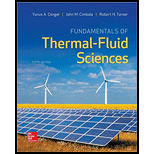
(a)
The rate of heat transfer in steady operation for the water in the tank is still.
(a)
Explanation of Solution
Given:
The outer diameter of the spherical tank
The surface temperature of vessel
The outside temperature of vessel
The circulation velocity of water in tank
Calculation:
Calculate the film temperature
Refer Table A-15 “Properties of saturated water”.
Obtain the following values of different properties corresponding film temperature
Calculate the characteristics length
Calculate the Reynolds number
Calculate the Nusselt number
Calculate the area of heat transfer
Calculate the heat transfer coefficient of convection
Calculate the heat transfer by convection
Thus, the of heat transfer in steady operation for the water in the tank is still is
(b)
The rate of heat transfer in steady operation for the water in the tank is still and the buoyancy force caused by the difference in water density is assumed to be negligible.
(b)
Explanation of Solution
Calculation:
If the buoyancy force becomes zero, the convective current becomes negligible means
Calculate the convective heat transfer
Calculate the heat transfer by conduction
Thus, the rate of heat transfer in steady operation for the water in the tank is still and the buoyancy force caused by the difference in water density is assumed to be negligible is
(c)
The rate of heat transfer in steady operation for the water in the tank is circulated at an average velocity of
(c)
Explanation of Solution
Calculation:
This condition is forced convection.
Refer Table A-15 “Properties of saturated water”.
Obtain the following values of different properties corresponding temperature
Calculate the Reynolds number
Calculate the Nusselt number
Calculate the convective heat transfer
Calculate the heat transfer by forced convection
Thus, the rate of heat transfer in steady operation for the water in the tank is circulated at an average velocity of
Want to see more full solutions like this?
Chapter 20 Solutions
Fundamentals of Thermal-Fluid Sciences
 Elements Of ElectromagneticsMechanical EngineeringISBN:9780190698614Author:Sadiku, Matthew N. O.Publisher:Oxford University Press
Elements Of ElectromagneticsMechanical EngineeringISBN:9780190698614Author:Sadiku, Matthew N. O.Publisher:Oxford University Press Mechanics of Materials (10th Edition)Mechanical EngineeringISBN:9780134319650Author:Russell C. HibbelerPublisher:PEARSON
Mechanics of Materials (10th Edition)Mechanical EngineeringISBN:9780134319650Author:Russell C. HibbelerPublisher:PEARSON Thermodynamics: An Engineering ApproachMechanical EngineeringISBN:9781259822674Author:Yunus A. Cengel Dr., Michael A. BolesPublisher:McGraw-Hill Education
Thermodynamics: An Engineering ApproachMechanical EngineeringISBN:9781259822674Author:Yunus A. Cengel Dr., Michael A. BolesPublisher:McGraw-Hill Education Control Systems EngineeringMechanical EngineeringISBN:9781118170519Author:Norman S. NisePublisher:WILEY
Control Systems EngineeringMechanical EngineeringISBN:9781118170519Author:Norman S. NisePublisher:WILEY Mechanics of Materials (MindTap Course List)Mechanical EngineeringISBN:9781337093347Author:Barry J. Goodno, James M. GerePublisher:Cengage Learning
Mechanics of Materials (MindTap Course List)Mechanical EngineeringISBN:9781337093347Author:Barry J. Goodno, James M. GerePublisher:Cengage Learning Engineering Mechanics: StaticsMechanical EngineeringISBN:9781118807330Author:James L. Meriam, L. G. Kraige, J. N. BoltonPublisher:WILEY
Engineering Mechanics: StaticsMechanical EngineeringISBN:9781118807330Author:James L. Meriam, L. G. Kraige, J. N. BoltonPublisher:WILEY





